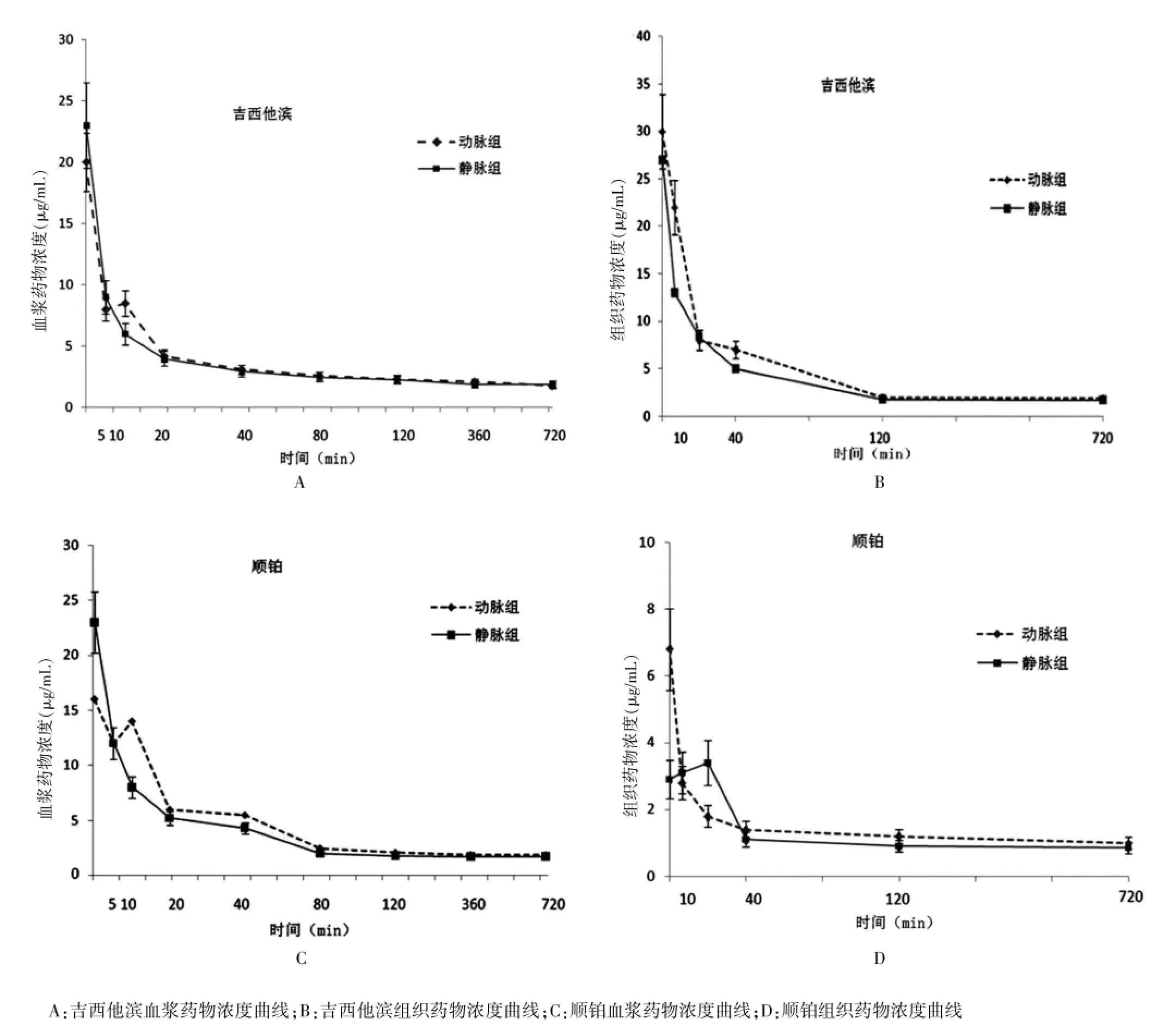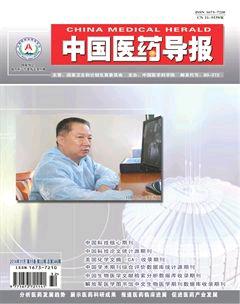吉西他滨及顺铂经动脉、静脉注射后血浆、组织药物浓度的变化
2014-03-17曹军何阳刘洪强王赛博赵保成郑晓辉汪茂文程英升
曹军 何阳 刘洪强 王赛博 赵保成 郑晓辉 汪茂文 程英升
1.苏州大学医学部,江苏苏州215123;2.上海市徐汇区大华医院介入肿瘤科,上海200237;3.上海交通大学附属第六人民医院放射科,上海200233
吉西他滨及顺铂经动脉、静脉注射后血浆、组织药物浓度的变化
曹军1袁2何阳2刘洪强2王赛博2赵保成2郑晓辉2汪茂文2程英升3▲
1.苏州大学医学部,江苏苏州215123;2.上海市徐汇区大华医院介入肿瘤科,上海200237;3.上海交通大学附属第六人民医院放射科,上海200233
目的分析不同化疗药物通过动脉及静脉途径注射后血浆及组织内药物浓度的变化情况。方法40只带瘤裸大鼠,随机分为8组,其中4组为动脉组,另4组为静脉组,带瘤裸大鼠分别经动脉及静脉注射吉西他滨及顺铂。于注射后5、10、20、40、80、120、360、720 min采血液标本,注射后10、40、120、720 min取组织标本,以高效液相色谱法测定血浆及肿瘤组织中吉西他滨浓度,ICP-MS法测定血浆及肿瘤组织中的铂含量,计算药代动力学参数。结果经动脉及静脉注射两种药物后,血浆及肿瘤组织中的药物浓度出现规律性变化,其变化过程均可用两室模型来描述。动脉注射两组药物的药代动力学参数与静脉注射的药代动力学参数不同,动脉组注射药物后,血浆药物峰浓度[吉西他滨:(20.84±10.11)μg/mL,顺铂:(15.13±7.12)μg/mL]均低于静脉组[吉西他滨:(28.96±7.02)μg/mL,顺铂:(21.64±9.72)μg/mL],靶组织内药物峰浓度[吉西他滨:(20.18±9.43)μg/mL,顺铂:(6.98±0.31)μg/mL]均高于静脉组[吉西他滨:(18.19±10.30)μg/mL,顺铂:(3.04±0.11)μg/mL],靶组织内药物曲线下面积[吉西他滨:(2641± 411)μg/(min·mL),顺铂:(6025±870)μg/(min·mL)]均明显高于静脉组[吉西他滨:(1663±568)μg/(min·mL),顺铂:(1780±883)μg/(min·mL)],差异均有统计学意义(P<0.05或P<0.01)。结论动脉注射吉西他滨和顺铂较静脉注射有不同程度的优势,这种优势与药物的药理特性有关。
吉西他滨曰顺铂曰药代动力学曰动脉注射
肺癌在我国居恶性肿瘤死亡的第1位,其发病率仍逐年上升[1]。肺癌分为非小细胞肺癌(non-small cell lung cancer,NSCLC)和小细胞肺癌(small cell lung cancer,SCLC)。非小细胞肺癌占肺癌总数的85%,其中肺腺癌占30%~40%[2]。大多数肺癌患者临床诊断时往往已属晚期,丧失了手术治疗时机。因此,在肺癌的治疗方案选择中,化疗药物仍然发挥着举足轻重的作用[3]。吉西他滨联合顺铂治疗肺癌的确切疗效在一些中外研究中已得到验证[4-5],但是两种药物不同给药途径治疗肺癌的疗效比较研究却鲜有报道。本研究通过动物实验研究吉西他滨及顺铂动脉化疗与静脉化疗的药代动力学表现,比较两种给药途径的药代动力学特点,以了解动脉化疗是否有其优势。
1 材料与方法
1.1 材料
1.1.1 细胞株
人肺癌细胞珠(A549)购自上海市肿瘤研究所。
1.1.2 实验动物
裸大鼠40只,8~10周龄,体重(180±15)g,SPF级,雌雄各半,实验动物购自上海市公共卫生临床中心实验动物部。饲养条件:各组鼠均同等自由饮水、摄食,温度22~25℃,相对湿度40%~50%。
1.1.3 药物
吉西他滨(商品名:泽菲,江苏豪森药业股份有限公司,批号:130611)及顺铂(德州德药制药有限公司;批号:WA2A1211085)。
1.2 仪器
Millipore超纯水机(美国Millipore公司)、Sigma 3K15高速低温离心机(德国Sigma公司)、2695型高效液相色谱仪、2487型紫外检测器、Millennium 3.2色谱处理软件(美国waters公司)、BP211D电子分析天平(德国Sartorius公司)、XW-80 A旋涡混合器(上海医科大学仪器厂)、惠普1100 HPLC系统。不锈钢手提式压力蒸汽灭菌器(合肥华泰医疗设备有限公司,YX-280A型)、质谱仪(美国PE公司,DRCⅡ型)、离心机(北京医用离心机厂,型号LD4-2)、洁净工作台(苏州安泰空气技术有限公司,型号SW-CJ-IFD)、光学显微镜(Olympus Optical Co.Ltd.,型号CHS No.100278)。
1.3 方法
1.3.1 细胞培养
将人肺癌A549细胞复苏,含10%小牛血清的DMEM培养液培养,取生长指数良好的人肺癌A549细胞,用0.25%胰蛋白酶消化,离心,收集细胞用磷酸盐缓冲液(PBS)稀释,浓度调整为5×106/mL,每只小鼠以0.2 mL接种于右腋皮下,待肿瘤长至体积约为1000 mm3时移植于裸大鼠耳后造模。
1.3.2 造模
选择生长良好、瘤结无破溃的荷瘤裸鼠,处死后无菌条件下完整剥离瘤结,剪开瘤结,清除中心坏死组织,在生理盐水下,用剪刀切成2 mm×2 mm×2 mm瘤组织块,每只裸大鼠右耳后皮下接种2 mm×2 mm× 2 mm瘤组织块,接种在30 min内完成。正常饲养8 d后动物接种肿瘤成功;待3周后肿瘤长至2650~2800 mm3,保证各组肿瘤平均体积无明显差异。
1.3.3 给药及取材
给药剂量:吉西他滨150 mg/kg,顺铂10 mg/kg。给药方法:①动脉化疗4组,荷瘤大鼠经10%水合氯醛(3.5 g/kg)腹腔注射麻醉后,沿颈部正中切开皮肤,暴露右颈动脉,于右颈动脉采用改良Seldinger技术插管,先造影证实肿瘤供血动脉,再经导管灌注吉西他滨150 mg/kg或顺铂10 mg/kg,缓慢推注,缝合皮肤。②静脉化疗4组,吉西他滨150 mg/kg或顺铂10 mg/kg由尾静脉注入。裸大鼠体内给药后获取标本:将40只裸大鼠随机分为8组,每组5只。在吉西他滨及顺铂分别动脉及静脉给药后5、10、20、40,80、120、360、720 min将裸大鼠获取血液标本,在10、40、120、720 min将裸大鼠处死获取肿瘤组织标本。血液收集于肝素抗凝管,离心后获取血浆。标本冷冻于-20℃冰箱保存。
1.3.4 药物浓度测定
1.3.4.1 吉西他滨药物分析用高效液相色谱法(惠普1100 HPLC系统)测定吉西他滨的血浆药物浓度。采用惠普Hypersil ODS分析柱(125 mm×4 mm,5μm)。流动相为水,流速为0.8 mL/min。紫外检测波长268 nm。测定方法的日间误差及日内误差均<10%。血浆样品的处理:血浆0.5 mL,加入0.1 mg/mL吉西他滨(内标)50 μL,以乙酸乙酯进行萃取,吹干氮气,用水溶解残留物后进样测定。组织标本的处理:在标本组织中分别加入0.1 mg/mL吉西他滨、0.1 mg/mL顺铂各50 μL和水2 mL,剪碎,匀浆30 min,取1 mL均匀血浆液,2000 r/min离心10 min,上清液以乙酸乙酯萃取,其余步骤与血浆样品处理相同。
1.3.4.2 铂含量检测吸取血浆200 μL,对组织样本进行称重,经湿法消解后,利用电感耦合等离子体质谱法(inductivelycoupledplasma-massspectrometry,ICP-MS)进行铂含量测定,分别以“铂含量/血浆含量(μg/mL)”、“铂含量/组织含量(μg/mL)”表示测定结果。通过以下公式将铂含量换算为药物含量,结果表示为“药物含量/血浆含量(μg/mL)”、“药物含量/组织含量(μg/mL)”:顺铂含量=检测的铂含量×300.05/195.08。ICP MS检测大鼠血浆、肿瘤铂含量的加标回收率分别为99.70%和97.30%。
1.4统计学方法
采用SPSS 13.0统计学软件进行数据分析,计量资料数据用均数±标准差(±s)表示,两组间比较采用t检验,以P<0.05为差异有统计学意义。应用DAS 2.0软件进行药代动力学分析。
2 结果
2.1 两组注射化疗药物后血浆及组织中的浓度变化情况比较
动脉及静脉组注射两组药物后,血浆及组织中的药物浓度出现规律性变化。如药物在血浆中的浓度变化,药物在组织中的浓度变化也可用数学模型来描述。吉西他滨血浆及组织中药物浓度变化符合药代动力学两室模型,用药0~40 min后,静脉组血浆药物浓度明显高于动脉组,并且随着时间延长,两组间血浆药物浓度差异渐消失;药物注射后动脉组及静脉组的药物峰浓度分别为(30.84±10.11)μg/mL及(48.96± 7.02)μg/mL,两组比较差异有高度统计学意义(P<0.01)。肿瘤组织内药物浓度水平动脉组与静脉组相似,峰浓度分别为(20.18±9.43)μg/mL和(18.19±10.30)μg/mL,差异有统计学意义(P<0.05)。动静脉组的血浆及组织药物峰浓度均在注射药物结束时出现(图1A~D)。

图1 两组大鼠注射吉西他滨及顺铂后血浆及组织药物浓度曲线
2.2 两组注射化疗药物后在组织和血浆中药代动力学参数比较
两组注射顺铂后,静脉组血浆药物峰浓度明显高于动脉组,其峰浓度分别为(21.64±9.72)μg/mL和(15.13±7.12)μg/mL,两组比较差异有高度统计学意义(P<0.01)。动脉组用药后10 min左右还可在血浆中见双峰现象,第2峰低于第1峰。两组用药后组织中药物峰浓度动脉组明显高于静脉组,两组比较差异有高度统计学意义(P<0.01),因顺铂存在组织吸收过程,静脉组的组织内药物峰浓度出现于用药后约28 min。见图1A、C。
2.3 两组注射化疗药物后的药代动力学参数变化
两组注射化疗药物后的药代动力学参数有所差异,从表1可以看出,动静脉组药物注射后,组织内药时曲线下面积(AUC)值动脉组均大于静脉组;血浆的AUC值动脉组均小于静脉组。两组注射药物后,组织内的药物消除速率常数(β)值动脉组明显低于静脉组,因药物在动脉组组织内滞留时间延长。
2.4 两组注射化疗药物后在组织和血浆中峰浓度比值的比较
动脉注射吉西他滨后,药物在组织与血浆中的峰浓度比值为(0.591±0.106),AUC比值为(4.61±2.07);静脉注射吉西他滨后,药物在组织与血浆中的峰浓度比值为(0.412±0.045),AUC比值为(2.31±0.961),动脉组显著高于静脉组(P<0.05)。动脉注射顺铂后,药物在组织与血浆中的峰浓度比值为(0.463±0.165),AUC比值为(3.58±0.625),静脉注射顺铂后,药物在组织与血浆中的峰浓度比值为(0.141±0.062),AUC比值为(2.04±1.66),动脉组显著高于静脉组(P<0.05)。
3 讨论
吉西他滨是目前NSCLC治疗最有效的第三代化疗药之一。其作用机制是在机体细胞内的核苷激酶作用下生成具有活性的二磷酸核苷(dFdCDP)及三磷酸核苷(dFdCTP),具有抑制细胞DNA合成的联合作用,从而发挥抗肿瘤作用,主要影响细胞DNA合成期(S期),阻止细胞从G1期进入S期。顺铂属细胞周期非特异性抗肿瘤药,作用机制为可将细胞阻滞于S期,因其与其他抗癌药物无交叉耐药性,故常与其他药物联用共同治疗肿瘤[5-8]。1998年美国食品药品监督管理局(FDA)根据相关临床试验结果,批准吉西他滨和顺铂联合化疗作为晚期NSCLC患者一线治疗方案。国内外多项体内外研究证实吉西他滨与顺铂联合用药可明显提高生存期,缓解全身症状及改善生活质量,治疗NSCLC效果明显优于以往的常规化疗方案[9-12]。
随着介入放射学的发展,经支气管动脉化疗目前已成为治疗不可切除性中、晚期肺癌的重要手段[13-15]。但肺癌介入治疗的化疗用药方案一般为顺铂、丝裂酶素C、5-氟尿嘧啶、表阿霉素等第二代药物化疗方案[15-16]。吉西他滨动脉灌注给药已经广泛用于肝转移瘤、胰腺癌和胆管肿瘤的介入治疗[17-22],但在肺癌的介入治疗中鲜有报道。通过对肺癌动物实验研究吉西他滨动脉用药与静脉用药的药物代谢动力学研究尚未见报道。在临床应用中,虽然裸小鼠肺癌模型制作比较成熟,但因其体积小无法行血管造影检查,不便在血管介入诊疗领域进行深入研究。其他大型动物却成瘤困难。本实验采用A549肺癌细胞株建立裸大鼠耳后移植瘤,建造肺癌模型,成瘤率高,便于动脉插管,它的成功制作有利于肺癌荷瘤动物动脉介入实验的顺利开展。
表1 两组大鼠注射化疗药后的药代动力学参数(±s)

表1 两组大鼠注射化疗药后的药代动力学参数(±s)
注:*P:两组血浆样本各参数比较P值;**P:两组组织样本各参数比较P值;α:分布速率常数;β:药物消除速率常数;Cmax(峰浓度)单位:μg/mL;AUC单位:血浆为μg/(min·mL),组织为μg/(min·mL)
组别只数吉西他滨α(/ m i n)β(/ m i n)CmaxA U C顺铂α(/ m i n)β(/ m i n)CmaxA U C静脉组血浆组织动脉组血浆组织*P值**P值6 6 6 6 0 . 2 8 9 ± 0 . 0 3 4 0 . 4 3 1 ± 0 . 2 7 1 0 . 0 0 4 5 ± 0 . 0 0 1 8 0 . 0 1 7 6 ± 0 . 0 0 7 6 2 8 . 9 6 ± 7 . 0 2 1 8 . 1 9 ± 1 0 . 3 0 7 2 0 ± 2 2 1 1 6 6 3 ± 5 6 8 0 . 0 8 2 ± 0 . 0 6 1 0 . 0 4 8 ± 0 . 0 2 8 0 . 0 0 3 4 ± 0 . 0 0 1 9 0 . 0 0 7 8 ± 0 . 0 0 5 3 2 1 . 6 4 ± 9 . 7 2 3 . 0 4 ± 0 . 1 1 1 6 8 3 ± 4 7 5 1 7 8 0 ± 8 8 3 0 . 2 3 0 ± 0 . 0 2 0 0 . 0 6 0 ± 0 . 0 2 8 0 . 0 0 0 0 . 0 0 6 0 . 0 0 7 4 ± 0 . 0 0 5 1 0 . 0 0 4 1 ± 0 . 0 0 1 3 0 . 0 4 1 0 . 0 0 0 2 0 . 8 4 ± 1 0 . 1 1 2 0 . 1 8 ± 9 . 4 3 0 . 0 0 0 0 . 0 3 2 5 7 3 ± 1 7 0 2 6 4 1 ± 4 1 1 0 . 0 0 6 0 . 0 0 8 0 . 0 3 8 ± 0 . 0 1 8 0 . 1 5 3 ± 0 . 0 9 2 0 . 0 1 8 0 . 0 0 1 0 . 0 0 0 6 ± 0 . 0 0 0 8 0 . 0 0 0 3 ± 0 . 0 0 0 2 0 . 0 0 2 0 . 0 3 5 1 5 . 1 3 ± 7 . 1 2 6 . 9 8 ± 0 . 3 1 0 . 0 0 3 0 . 0 0 1 8 7 3 ± 2 6 0 6 0 2 5 ± 8 7 0 0 . 0 0 3 0 . 0 0 0
研究发现动脉化疗与静脉化疗相比有独特优势[17,23-25]。首先,动脉注射药物后,靶组织药物峰浓度较高,滞留时间也较长,有利于其药效发挥,并且动脉给药后血浆药物峰浓度及AUC值相对较低,可减少化疗药物全身毒性。局部组织滞留化疗药物的能力是动脉给药的主要优势,而药物的药理特性决定化疗药物药物在组织中的滞留时间。动脉给药,可使药物首先从血浆分布至靶组织,再从靶组织进入循环系统,分布到其他组织中去;而对于静脉注射,化疗药物首先进入循环系统,再分布至靶组织。由于动脉及静脉注射药物经历不同代谢过程,其药代动力学参数必然有所差异。本研究发现动脉或静脉注药后,组织及血浆中药物浓度出现规律性变化,可以用两室模型描述其变化过程。另外,本研究也发现药物浓度在血浆分布相快速降低的同时,组织药物浓度也快速下降,这可能是由于血浆药物浓度下降加速了药物从组织向血浆中的转运。
吉西他滨和顺铂两组药物经颈内动脉及尾静脉注射后,血浆及组织中的浓度变化有不同特点。吉西他滨注射后,血浆及组织峰浓度均在注射结束后出现,药物分配快。顺铂注射后,静脉组靶组织内药物峰浓度出现于注射后28 min,而动脉组出现于注射完毕时。可见,顺铂静脉注射后存在较缓慢的组织吸收过程,这可能与顺铂的蛋白结合率高及结合力强有关。动脉注射后,顺铂首先经过靶组织,大量游离顺铂快速分布到靶组织中,而静脉注射后顺铂首先进入全身循环与血浆蛋白结合,减缓了顺铂在组织的分布速度,并减少其在组织中分布浓度。组织内AUC定义为药物在组织内浓度和时间的乘积,是组织与药物接触程度的量化指标。药物在组织内的AUC值与峰浓度可作为药物对靶组织作用强度的指标,或作为对全身作用强度的指标,也可通过比较靶组织与血浆中药物的AUC比值及峰浓度反映动静脉用药的优劣。
动脉及静脉注射吉西他滨和顺铂较静脉注射有不同程度的优势。组织内药代动力学参数α、β值反映组织内药物向血浆转运的速度,而血浆内的α、β值反映药物从血浆向组织的分布速度及药物从血浆的消除速度,α、β值与药物从血浆或组织的排除速度呈正相关。本研究发现,动脉注射吉西他滨后,组织内α、β值均小于血浆α、β值,表明动脉注射优势本质上是药物在组织中的转运速率低于药物在血浆中的分布及消除速率。动脉注射顺铂后,这种优势体现于有更多游离顺铂进入靶组织中。若将吉西他滨及顺铂联合治疗可能有药代动力学的互补作用。
[1]Di JZ,Peng JY,Wang ZG.Prevalence,clinicopathological characteristics,treatment,and prognosis of intestinal metastasisofprimarylungcancer:acomprehensivereview[J].Surgical Oncology,2014,23(2):72-80.
[2]Liu Y,Chen LP.The regulation of cell polarity in the progression of lung cancer[J].Journal of Cancer Research and Therapeutics,2013,9(Suppl 2):S80-85.
[3]Li W,Liu HY,Jia ZR,et al.Advances in the early detection of lung cancer using analysis of volatile organic compounds:from imaging to sensors[J].Asian Pacific Journal of Cancer Prevention:APJCP,2014,15(11):4377-4384.
[4]Zhou M,Ding YJ,Feng Y,et al.Association of xeroderma pigmentosum group D(Asp312Asn,Lys751Gln)and cytidine deaminase(Lys27Gln,Ala70Thr)polymorphisms with outcomeinChinesenon-smallcelllungcancerpatientstreated with cisplatin-gemcitabine[J].Genetics and Molecular Research:GMR,2014,13(2):3310-3318.
[5]Li Y,Wang LR,Chen J,et al.First-line gemcitabine plus cisplatin in nonsmall cell lung cancer patients[J].Disease Markers,2014,2014:960458.
[6]Gridelli C,Novello S,Zilembo N,et al.PhaseⅡrandomized study of vandetanib plus gemcitabine or gemcitabine plus placebo as first-line treatment of advanced nonsmall-cell lung cancer in elderly patients[J].Journal of Thoracic Oncology:Official Publication of the International Association for the Study of Lung Cancer,2014,9(5):733-737.
[7]Juan O,Vidal J,Gisbert R,et al.Prognostic significance of circulating tumor cells in advanced non-small cell lung cancer patients treated with docetaxel and gemcitabine[J]. Clinical&Translational Oncology:official publication of the Federation of Spanish Oncology Societies and of the National Cancer Institute of Mexico,2014,16(7):637-643.
[8]Galvani E,Toffalorio F,Peters GJ,et al.Pharmacogenetics of Non-small Cell Lung Cancer(NSCLC):Time to"Work it Out"?[J].Current Pharmaceutical Design,2014,20(24):3863-3874.
[9]Yang F,Li X,Chen KZ,et al.Tolerability and toxicity of adjuvant cisplatin and gemcitabine for treating non-small cell lung cancer[J].Chinese Medical Journal,2013,126(11):2087-2091.
[10]TangY,WangY,TengX.Sequencedependenteffect of gemcitabine and cisplatin on A549 nonsmallcell lung cancer cells[J].Molecular Medicine Reports,2013,8(1):221-226.
[11]Morabito A,Gebbia V,Di Maio M,et al.Randomized phaseⅢtrial of gemcitabine and cisplatin vs.gemcitabine alone in patients with advanced non-small cell lung cancer and a performance status of 2:the CAPPA-2 study[J]. Lung Cancer,2013,81(1):77-83.
[12]Ozkaya S,Findik S,Dirican A,et al.Long-term survival rates of patients with stageⅢb andⅣnon-small cell lung cancer treated with cisplatin plus vinorelbine or gemcitabine[J].Experimental and Therapeutic Medicine,2012,4(6):1035-1038.
[13]Wu CF,Lee CH,Hsi E,et al.Interval between intra-arterial infusion chemotherapy and surgery for locally advanced oral squamous cell carcinoma:impacts on effectiveness of chemotherapy and on overall survival[J].TheScientific World Journal,2014,2014:568145.
[14]Ma MC,Chen YY,Li SH,et al.Intra-arterial chemotherapywith Doxorubicin and Cisplatin is effective for advanced hepatocellular cell carcinoma[J].The Scientific WorldJournal,2014,2014:160138.
[15]Yuan Z,Li WT,Ye XD,et al.Intra-arterial infusion chemotherapy for advanced non-small-cell lung cancer:preliminary experience on the safety,efficacy,and clinical outcomes[J].Journal of Vascular and Interventional Radiology:JVIR,2013,24(10):1521-1528.
[16]Nakanishi MY,oshida Y,Natazuka T.Prospective study of transarterial infusion of docetaxel and cisplatin to treat non-small-cell lung cancer in patients contraindicated for standard chemotherapy[J].Lung Cancer,2012,77(2):353-358.
[17]Heinrich S,Kraft D,Staib-Sebler E,et al.PhaseⅡstudy on combined intravenous and intra-arterial chemotherapy withgemcitabineandmitomycinCinpatientswithadvanced pancreatic cancer[J].Hepato-gastroenterology,2013,60(126):1492-1496.
[18]Spada F,Fazio N,Bonomo G,et al.Hepatic intra-arterial chemotherapy in patients with advanced primary liver tumours[J].Ecancer Medical Science,2012,6:280.
[19]Hong GB,Zhou JX,Sun HB,et al.Continuous transarterial infusionchemotherapywithgemcitabineand5-Fluorouracil for advanced pancreatic carcinoma[J].Asian Pacific Journal of Cancer Prevention:APJCP,2012,13(6):2669-2673.
[20]Uwagawa T,Misawa T,Tsutsui N,et al.PhaseⅡstudy of gemcitabine in combination with regional arterial infusion of nafamostat mesilate for advanced pancreatic cancer[J]. American Journal of Clinical Oncology,2013,36(1):44-48.
[21]Tanaka T,Nishiofuku H,Tamamoto T,et al.Intra-arterial chemoinfusion prior to chemoradiotherapy with full-dose systemic gemcitabine for management of locally advanced pancreatic cancer[J].Anticancer Research,2011,31(11):3909-3912.
[22]Guiu B,Vincent J,Guiu S,et al.Hepatic arterial infusion of gemcitabine-oxaliplatin in a large metastasis from colon cancer[J].World Journal of Gastroenterology:WJG,2010,16(9):1150-1154.
[23]Shields CL,Kaliki S,Al-Dahmash S,et al.Management of advanced retinoblastoma with intravenous chemotherapy then intra-arterial chemotherapy as alternative to enucleation[J].Retina,2013,33(10):2103-2109.
[24]Shields CL,Fulco EM,Arias JD,et al.Retinoblastoma frontiers with intravenous,intra-arterial,periocular,and intravitreal chemotherapy[J].Eye,2013,27(2):253-264.
[25]Fiorentini G,Aliberti C,Tilli M,et al.Intra-arterial infusion of irinotecan-loaded drug-eluting beads(DEBIRI)versus intravenous therapy(FOLFIRI)for hepatic metastases from colorectal cancer:final results of a phaseⅢstudy[J].Anticancer Research,2012,32(4):1387-1395.
Concentratin change of chemotherapeutic agents in plasma and tissue af-ter intraarterial and intravenous injection Gemcitabine and Cisplatin
CAO Jun1,2HE Yang2LIU Hongqiang2WANG Saibo2ZHAO Baocheng2ZHENG Xiaohui2WANG Maowen2CHENG Yingsheng3▲1.Medical College of Soochow University,Jiangsu Province,Suzhou215123,China;2.Department of Interventional oncology,Dahua Hospital of Xuhui District in Shanghai,Shanghai200237,China;3.Department of Radiology,Shanghai Jiao Tong University Affiliated the Sixth People's Hospital,Shanghai200233,China
Objective To study the drug concentration change of chemotherapeutic agents in plasma and tissue after arterial and intravenous injection.Methods Gemcitabine and Cisplatin were injected into the 40 mature nude rats with xenografted tumor.The rats were divided into vein injection group and artery injection group randomly.The rats were given Gemcitabine and Cisplatin respectively.Blood samples were collected at 5,10,20,40,80,120,360,720 min after injection and the tumor tissue specimens were collected at 10,40,120,720 min after injection.Gemcitabine concentration in plasma and tumor tissues were determined by high performance liquid chromatography(HPLC)method, while Cisplatin was determined by inductively coupled plasma-mass spectrometry(ICP-MS)method.The data were analyzed by the pharmacokinetic program.Results Regular concentration change of the three drugs in plasma and tissues were observed after the intravenous and arterial injection,which met the two-compartment model.The pharmacokinetic parameters of the two drugs after intravenous and arterial injection were different.The peak concentration in plasma of artery injection group[Gemcitabine:(20.84±10.11)μg/mL;Cisplatin:(15.13±7.12)μg/mL] were lower than those of the vein injection group[(Gemcitabine:(28.96±7.02)μg/mL;Cisplatin:(21.64±9.72)μg/mL], the peak concentration in tissues of the arterial injections group[Gemcitabine:(20.18±9.43)μg/mL;Cisplatin:(6.98± 0.31)μg/mL]were higher than those of the intravenous injection group[Gemictabine:(18.19±10.30)μg/mL;Cisplation: (3.04±0.11)μg/mL],and area under curve(AUC)value[(Gemcitabine:(2641±411)μg/(min·mL);Cisplatin:(6025±870) μg/(min·mL)],in tissues of the arterial injections group were higher than those of the intravenous injection group [Gemcitabine:(1663±568)μg/(min·mL);Cisplatin:(1780±883)μg/(min·mL)].Conclusion Intraarterial chemotherapy has advantages to intravenous chemotherapy in gemcitabine and cisplatin.These advantages depend on the drug pharmacological properties.
Gemcitabine;Cisplatin;Pharmacokinetics; Intraarterial injection
R730.53
A
1673-7210(2014)11(b)-0008-06
2014-08-07本文编辑:任念)
上海市自然科学基金项目(编号12ZR1428900);上海市卫生和计划委员会青年科研项目(编号20124Y096)。
▲通讯作者
